Icy driveways, steps, and sidewalks are a hazard that’s tough to deal with. A snow shovel alone won’t do the trick. And by now, most of us are aware that rock salt causes a whole different set of expensive problems.
Fortunately, there are a lot of better and safer options for melting ice. Here, we’ll talk briefly about what works and what doesn’t. Then we’ll give you some recommendations about specific brands!
Why Not Rock Salt?
Over the past couple of decades, we’ve realized how harmful “rock salt” really is. Or maybe we already knew it, but just now see that we have other, better options.
Rock salt is sodium chloride (NaCl). It’s basically the same as table salt, although it doesn’t go through all the same treatments or have iodine added.
When sodium chloride interacts with water, it makes water freeze at a lower temperature. So instead of starting to freeze at 32°F, the water will stay liquid a few degrees colder. So if the air and ground temperature aren’t far below freezing, the ice will melt.
However, rock salt is highly corrosive. That means it will eat through other materials, too. It can damage concrete, asphalt, and wood. It can stick to the underside of your car and make it rust. And you might track it into your house on your boots or pant legs where it will damage your floors and carpets. It’s also bad for your pets!
Because of this, rock salt has largely fallen into disuse as an ice melt.
What Works Best?
There are several alternatives to rock salt, some more effective than others. No matter which you choose, be sure to use your ice melt correctly!
Calcium Chloride
Calcium Chloride (CaCl2) does a great job of getting rid of ice. It absorbs moisture and begins to dissolve the ice. This process actually creates heat – it can even raise the temperature to 140°F in its tiny space! That, of course, helps melt the adjacent ice and snow.
Calcium chloride is fantastic on concrete at “normal” usage levels, although extremes can always do damage. Like most other products, though, it can burn a pet’s paws and be dangerous if they consume it (including by licking it off their paws).
Calcium Magnesium Acetate
This mixture is most commonly a liquid, unlike other ice melts that are granular or pellets. Calcium magnesium acetate is concrete-safe and biodegradable. It works better at preventing freezing than at melting already-frozen water. So it’s better to use later in the day before the sun goes down.
Because of the way it works, it does form a slush, so you’ll need to shovel or push it away.
CMA is great for newer concrete that was poured less than two years prior. It works at temperatures as low as 20°F.
Magnesium Chloride
Another quality product that works at low temperatures (all the way down to 8°F), magnesium chloride (MgCl2) is relatively less corrosive than rock salt. It’s also considered “more” pet safe, although you should still keep an eye on your pets around it.
The drawbacks, though, are that you need to use more of it to get the job done, and it’s more expensive. That’s a double whammy!
Potassium Chloride
Efficient at melting, potassium chloride is relatively expensive and also damages concrete. It can get the job done and is used at times, but isn’t great for sidewalks, patios, or other concrete surfaces.
Urea
Urea is another chemical that’s used in some ice melts. Sometimes called carbamide, its chemical composition is (NH2)2CO.
It does not come from urine, as some assume. It actually comes from natural gas and is commonly used in fertilizers since it contains a lot of nitrogen.
Compared to other ice melts, it can be a bit less corrosive than others. That means it may irritate pet paws less, although in large concentrations they’ll still feel irritation.
Are They Really Pet Safe?
“Pet safe” seems like a relative term when it comes to ice melts. Most manufacturers seem to use it to mean that their product is not toxic to your animal. However, almost all ice melts are corrosive to some degree, so they will irritate paws (and your skin, too). Be sure to spread it out as indicated on the directions to minimize the impact.
Best Ice Melts
Here are some of the top ice melt products we’ve come across so far. Be sure to get enough before the storm!
Morton Snow & Ice Melt
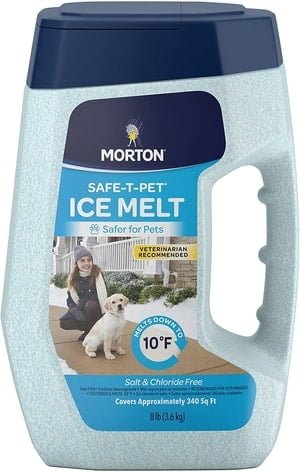
We’ve listed this product first because it’s recommended by the American Kennel Club for being the best pet-safe snowmelt.
This melt actually relies on urea rather than any of the other materials we’ve mentioned above. It actually contains no chloride or salt.
It does a good job of melting without being toxic to pets. It can cause some stomach distress to dogs, but will not lead to long-term damage. This mix doesn’t damage your concrete, either.
It works at temperatures as low as 10°F. This 8-pound container can melt the ice on a 2-car driveway (about 340 square feet).
Snow Joe Melt EB
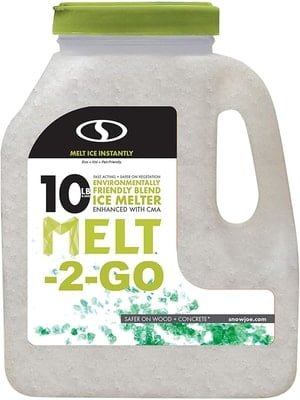

This Snow Joe ice melt is calcium chloride but it’s “enhanced with” calcium magnesium acetate. Those are our two favorite products for their sheer melting power! Of course, it can still be corrosive so be sure to follow the directions so you don’t overuse it and damage your concrete.
We haven’t been able to find details on the exact composition of the mixture, but we do see a lot of dog owners saying that it does irritate paws.
This is available in a 10-pound jug or a 25-pound bag or bucket.
Overall, it’s fantastic for cutting through the ice. But we recommend extra care if your pets (or your neighbors) will have to walk on it.
Green Gobbler 96% Pure Calcium Chloride Snow & Ice Melt Pellets
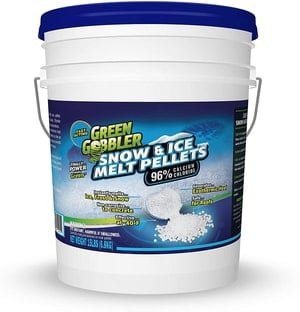

Another calcium chloride treatment, Green Gobbler comes in 15-pound, 25-pound, and 35-pound buckets.
According to the company, this de-icer will work down to 40 below zero! We haven’t had the opportunity to try it anywhere near that, and it does seem a bit out of line compared to similar products. However, we suppose it could be somewhat effective at that level.
At 96% calcium chloride and no rock salt, it’s better than rock salt at protecting your concrete. It can still be irritating for pets. And overuse can cause corrosion. In general, though, it’s great for asphalt or concrete.
Scotwood Industries 50B-RR Road Runner Premium Ice Melter, 50-pound
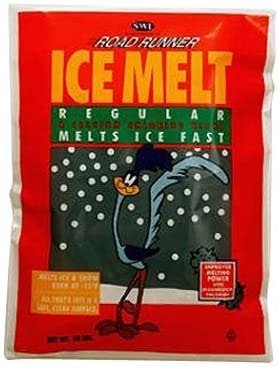
This 50-pound bag of ice melt is fantastic if you have a large area to clear or if you want to be prepared for a long, harsh winter. It works well even if the temperatures drop to -15°F.
This is a mix of pretty much all of the melting agents – it includes rock salt, calcium chloride, and potassium chloride. That means it can still be somewhat corrosive but not nearly as bad as pure rock salt.
It does a great job melting the ice. It also doesn’t seem to leave marks on your concrete as it melts.
HARRIS Safe Melt
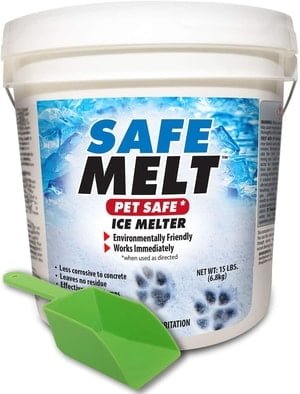

Harris offers these magnesium chloride pellets in a 15-pound bucket. They even toss in a scoop – not a big deal, but it’s still nice to have in case you don’t have anything else handy.
The pellets do a good job melting through the ice at temperatures as low as 13 below zero. Since it’s less corrosive than rock salt, you won’t have to worry as much about your concrete. It may still irritate pet paws, but this seems better than most.
The biggest issue we saw with this is that it’s a pain to open the bucket the first time. It can be tough to pry the lid off. You’ll probably need a screwdriver to open the tabs that hold the lid in place.
Conclusion
Getting the ice off your sidewalks and driveways is an important safety step for anyone who lives in a region where temperatures drop below freezing. Fortunately, there are a lot of great ice melt products available. Be sure to choose one that will work well with your surface and do minimal damage to the environment – and to your pets!









